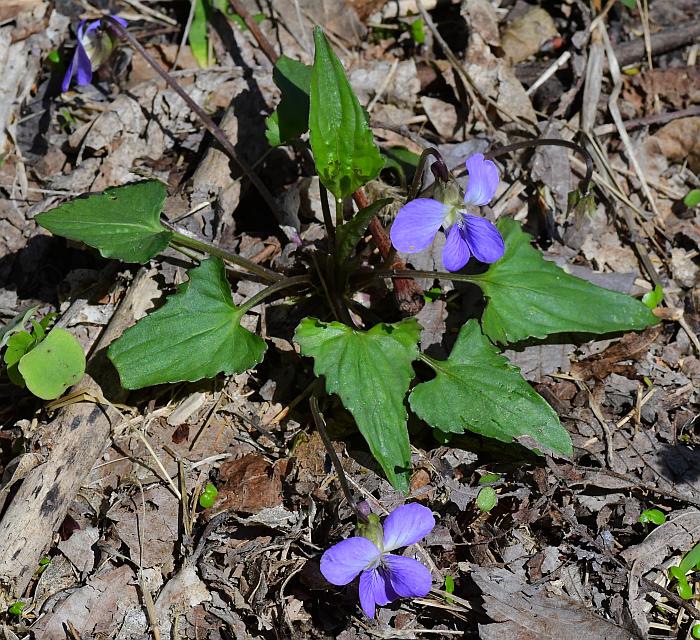Viola missouriensis Greene
Missouri Violet

Native
CC = 6
CW = 0
MOC = 66
© SRTurner
Viola missouriensis GreeneMissouri Violet | |
 |
Native CC = 6 CW = 0 MOC = 66 |
© SRTurner |
|
Family - Violaceae Habit - Perennial forb from a prostrate to ascending rhizome 4-6 mm thick, to 40 cm tall. Stems - Aerial stems not produced. Leaves - Leaves in a basal rosette, long-petiolate, the petiole glabrous. Stipules conspicuous, membranous to somewhat herbaceous, free from the petiole, narrowly lanceolate, the margins entire, glandular-hairy. Leaf blades 2-8 cm long, distinctly longer than wide, narrowly triangular to ovate-triangular, all unlobed, angled or tapered to a usually sharply pointed tip, truncate to shallowly cordate at the base, the margins finely to coarsely toothed, mostly in the basal 2/3, subentire in the apical 1/3, the surfaces glabrous. Considerable variation in blade shape often present.
Inflorescence - Multiple pedunculate flowers arising from an underground rhizome. Flower stalks to 12 cm, slightly overtopping the leaves, glabrous, with a pair of opposing or alternate bracts about 1/2 way up the peduncle. Bracts glabrous, minute, lanceolate, 3 mm long, 1 mm broad. Cleistogamous flowers produced, the stalks arched or spreading.
Flowers - Sepals 6-8 mm long, oblong-lanceolate to broadly lanceolate, angled to a rounded or bluntly pointed tip, the margins glabrous, the basal auricles inconspicuous (0.5-1.0 mm long at flowering, not accrescent). Corollas 10-18 mm long (except in cleistogamous flowers), the 5 petals oriented more or less forward in life but curved or arched outward or backward toward their tips, longer than the sepals, lilac to bluish purple, the throat whitened and sometimes with a dark border and often with somewhat darker veins, the lateral petals bearded on the upper surface with uniformly slender hairs (a few of these occasionally slightly thickened toward their tips), the lower petal glabrous or nearly so, the spur conspicuous, usually well-exserted beyond the sepal auricles, stout and often somewhat hemispheric in shape. Stamens not exserted, typically not visible without dissection of the flower. Style slender, slightly expanded into a narrow, more or less scoop-shaped, hollow, truncate tip. Stamens 5, erect, connivent around the ovary. Filaments 2.5 mm long, 1.5 mm broad, whitish, with an orangish expanded anther connective to 2 mm long, 2 mm broad, glabrous. Anthers connected vertically to the filament, opening longitudinally, whitish. Bottom two anthers with a reniform nectary which fills the spur of the flower. Ovary green, 3 mm long, 2 mm in diameter, cylindric-ovoid, glabrous, unilocular, with many ovules. Stigma greenish, 1 mm broad, truncate.
Fruits - Capsules 7-9 mm long, broadly ellipsoid to broadly ovoid, green to olive green, often mottled with dark purple, the surface glabrous. Seeds 1.5-2.2 mm long, brown. Flowering - March - May. Habitat - Bottomland and mesic forests, streambanks, sloughs, pond margins, bottomland prairies, marshes, ditches, fields, lawns, railroads, roadsides and disturbed areas. Origin - Native to the U.S. Lookalikes - V. sororia Other info. - This violet can be found throughout most of Missouri, with the possible exception of the central Ozarks. Beyond Missouri its range is comprised primarily of a broad band extending from Minnesota to the Gulf of Mexico. The plant's appearance is similar to that of the common violet V. sororia, but can be distinguished by the leaves. These are typically triangular in shape, longer than wide, truncate at the base, and with very shallow or no teeth toward the apex. There is considerable variation in leaf shape, so several leaves should be examined (from multiple plants, if possible). Other attributes are hairs in the corolla throat which are uniformly slender (sometimes slightly expanded toward the tip), and a corolla color which tends to be lighter than that of the common violet. Photographs taken at Eagle Bluffs Conservation Area, Boone County, MO., 4-18-04 (DETenaglia); also along the Katy Trail near Dutzow, Warren County, MO, 4-18-2022 (SRTurner). |